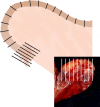Endometrial Carcinoma, Grossing and Processing Issues: Recommendations of the International Society of Gynecologic Pathologists
- PMID: 30550481
- PMCID: PMC6296844
- DOI: 10.1097/PGP.0000000000000552
Endometrial Carcinoma, Grossing and Processing Issues: Recommendations of the International Society of Gynecologic Pathologists
Abstract
Endometrial cancer is the most common gynecologic neoplasm in developed countries; however, updated universal guidelines are currently not available to handle specimens obtained during the surgical treatment of patients affected by this disease. This article presents recommendations on how to gross and submit sections for microscopic examination of hysterectomy specimens and other tissues removed during the surgical management of endometrial cancer such as salpingo-oophorectomy, omentectomy, and lymph node dissection-including sentinel lymph nodes. In addition, the intraoperative assessment of some of these specimens is addressed. These recommendations are based on a review of the literature, grossing manuals from various institutions, and a collaborative effort by a subgroup of the Endometrial Cancer Task Force of the International Society of Gynecological Pathologists. The aim of these recommendations is to standardize the processing of endometrial cancer specimens which is vital for adequate pathological reporting and will ultimately improve our understanding of this disease.
Conflict of interest statement
The authors declare no conflict of interest.
Figures









References
-
- Lortet-Tieulent J, Ferlay J, Bray F, et al. International patterns and trends in endometrial cancer incidence, 1978-2013. J Natl Cancer Inst 2017;110:354–361. - PubMed
-
- American Cancer Society. Cancer Facts & Figures. Altanta CA: American Cancer Society; 2018.
-
- Hicks DG, Boyce BF. The challenge and importance of standardizing pre-analytical variables in surgical pathology specimens for clinical care and translational research. Biotech Histochem 2012;87:14–7. - PubMed
-
- Khoury T. Delay to formalin fixation alters morphology and immunohistochemistry for breast carcinoma. Appl Immunohistochem Mol Morphol 2012;20:531–42. - PubMed

